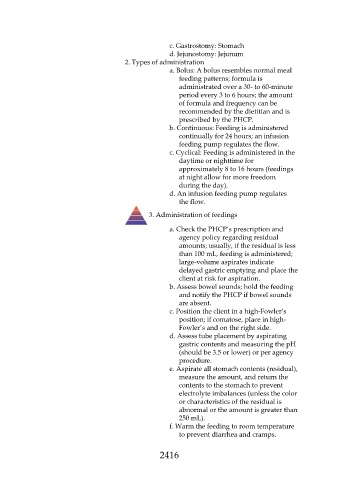Page 2416 - Saunders Comprehensive Review For NCLEX-RN
P. 2416
c. Gastrostomy: Stomach
d. Jejunostomy: Jejunum
2. Types of administration
a. Bolus: A bolus resembles normal meal
feeding patterns; formula is
administrated over a 30- to 60-minute
period every 3 to 6 hours; the amount
of formula and frequency can be
recommended by the dietitian and is
prescribed by the PHCP.
b. Continuous: Feeding is administered
continually for 24 hours; an infusion
feeding pump regulates the flow.
c. Cyclical: Feeding is administered in the
daytime or nighttime for
approximately 8 to 16 hours (feedings
at night allow for more freedom
during the day).
d. An infusion feeding pump regulates
the flow.
3. Administration of feedings
a. Check the PHCP’s prescription and
agency policy regarding residual
amounts; usually, if the residual is less
than 100 mL, feeding is administered;
large-volume aspirates indicate
delayed gastric emptying and place the
client at risk for aspiration.
b. Assess bowel sounds; hold the feeding
and notify the PHCP if bowel sounds
are absent.
c. Position the client in a high-Fowler’s
position; if comatose, place in high-
Fowler’s and on the right side.
d. Assess tube placement by aspirating
gastric contents and measuring the pH
(should be 3.5 or lower) or per agency
procedure.
e. Aspirate all stomach contents (residual),
measure the amount, and return the
contents to the stomach to prevent
electrolyte imbalances (unless the color
or characteristics of the residual is
abnormal or the amount is greater than
250 mL).
f. Warm the feeding to room temperature
to prevent diarrhea and cramps.
2416

